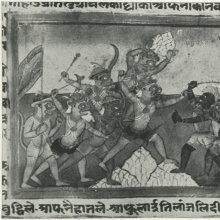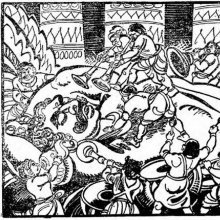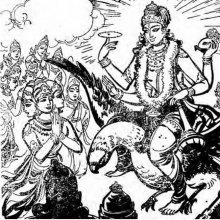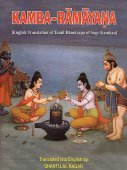Kumbhakarna, Kumbhakarṇa, Kumbha-karna: 21 definitions
Introduction:
Kumbhakarna means something in Buddhism, Pali, Hinduism, Sanskrit, Jainism, Prakrit, the history of ancient India, Marathi. If you want to know the exact meaning, history, etymology or English translation of this term then check out the descriptions on this page. Add your comment or reference to a book if you want to contribute to this summary article.
Images (photo gallery)
In Hinduism
Purana and Itihasa (epic history)
Source: archive.org: Puranic EncyclopediaKumbhakarṇa (कुम्भकर्ण).—Genealogy. Descended from Viṣṇu thus: Brahmā—Pulastya—Viśravas—Kumbhakarṇa. (See full article at Story of Kumbhakarṇa from the Puranic encyclopaedia by Vettam Mani)
Source: WikiPedia: RamayanaKumbhakarna is a rakshasa and brother of Ravana in the Indian Ramayana epic. Despite his monstrous size and great hunger, he was described to be of good character, though he killed and ate many Hindu monks just to show his power. Kumbhakarna had two sons, Kumbha and Nikumbha, who too fought in the war against Rama and were killed.
Source: Cologne Digital Sanskrit Dictionaries: The Purana IndexKumbhakarṇa (कुम्भकर्ण).—A son of Viśravas and Kaikarī, killed by Rāma in the Lankā war;1 a brother of Rāvaṇa.2
- 1) Bhāgavata-purāṇa IV. 1. 37; VII. 1. 43; 10. 36; IX. 10. 18; Vāyu-purāṇa 70. 41.
- 2) Brahmāṇḍa-purāṇa III. 8. 47; IV. 29. 113 and 116.
Kumbhakarṇa (कुम्भकर्ण) is one of the sons of Kaikasī and Viśravas, according to one account of Vaṃśa (‘genealogical description’) of the 10th century Saurapurāṇa: one of the various Upapurāṇas depicting Śaivism.—Accordingly, [...] Viśravas was born to [Ilavilā and Pulastya]. Viśravas had four wives—Puṣpotkaṭā, Vākā, Kaikasī and Devavarṇinī. From Kaikasī were born Rāvaṇa, Kumbhakarṇa, Vibhīṣaṇa and Śūrpaṇakhā.

The Purana (पुराण, purāṇas) refers to Sanskrit literature preserving ancient India’s vast cultural history, including historical legends, religious ceremonies, various arts and sciences. The eighteen mahapuranas total over 400,000 shlokas (metrical couplets) and date to at least several centuries BCE.
General definition (in Hinduism)
Source: Wisdom Library: HinduismKumbhakarṇa (कुम्भकर्ण, “jar’s-ear”):—In Vedic hinduism, he is one of the half-brothers of Kubera, who was the Vedic God of wealth presiding over all earthly treasures.
Source: Apam Napat: Indian MythologyKumbhakarna was the brother of King Ravana of Lanka. Ravana, Kumbhakarna, Vibhishana were the sons of a sage named Vishrava, born to a Rakshasa woman named Kaikasi. They had a sister named Shurpanakha. Kubera is their half-brother, born to another wife of Vishrava.
He was a giant in stature, and consumed huge amounts of food when he was awake. One of the most powerful warriors on Ravana's side, he was also very knowledgeable about proper conduct. Like his brother Vibhishana, he counselled Ravana to return Sita to Rama to avert the war, but unlike Vibhishana, he did not abandon Ravana when his advice was rejected.
He fought valiantly against the Vanara army of Rama, causing great damage. Ultimately, he was slain by Laxmana with the help of a divine missile. Though he fought on the side of evil, his devotion to Ravana and his loyalty to his kinsmen is highly praised, and is contrasted favorably with the "treachery" of his brother Vibhishana, who fought on Rama's side.
In Buddhism
Tibetan Buddhism (Vajrayana or tantric Buddhism)
Source: Wisdom Library: Tibetan BuddhismKumbhakarṇa (कुम्भकर्ण) is the name of a Rākṣasa mentioned as attending the teachings in the 6th century Mañjuśrīmūlakalpa: one of the largest Kriyā Tantras devoted to Mañjuśrī (the Bodhisattva of wisdom) representing an encyclopedia of knowledge primarily concerned with ritualistic elements in Buddhism. The teachings in this text originate from Mañjuśrī and were taught to and by Buddha Śākyamuni in the presence of a large audience (including Kumbhakarṇa).

Tibetan Buddhism includes schools such as Nyingma, Kadampa, Kagyu and Gelug. Their primary canon of literature is divided in two broad categories: The Kangyur, which consists of Buddha’s words, and the Tengyur, which includes commentaries from various sources. Esotericism and tantra techniques (vajrayāna) are collected indepently.
In Jainism
General definition (in Jainism)
Source: Wisdom Library: JainismKumbhakarṇa (कुम्भकर्ण) is another name of Bhānukarṇa, who is a brother of Rāvaṇa: the eighth Prativāsudeva, according to both Śvetāmbara and Digambara sources. Jain legends describe nine such Prativāsudevas (anti-heroes) usually appearing as powerful but evil antagonists instigating Vāsudeva by subjugating large portions of Bharata-land. As such, they are closely related with the twin brothers known as the Vāsudevas (“violent heroes”) and the Baladevas (“gentle heroes”).
According to the Triṣaṣṭiśalākāpuruṣacarita 7.1, the mother of Kumbhakarṇa (Bhānukarṇa) and Rāvaṇa is named Ratnaśravas and his mother Kaikasī. They have another brother named Bibhīṣaṇa, and a sister named Candraṇakhā (or Śūrpaṇakhā).
The Prativāsudevas (such as Daśamukha) fight against the twin-heroes with their cakra-weapon but at the final moment are killed by the Vāsudevas. Their stories are narrated in the Triṣaṣṭiśalākāpuruṣacarita (“the lives of the sixty-three illustrious persons”), a twelfth-century Śvetāmbara work by Hemacandra.
Source: archive.org: TrisastisalakapurusacaritraKumbhakarṇa (कुम्भकर्ण) (also called Bhānukarṇa) is a son of Rākṣasa Ratnaśravas (son of Sumālin) and Vidyādharī Kaikasī (daughter of Vyomabindu), according to the Jain Ramayana and chapter 7.1 [origin of the rākṣasavaṃśa and vānaravaṃśa] of Hemacandra’s 11th century Triṣaṣṭiśalākāpuruṣacaritra: an ancient Sanskrit epic poem narrating the history and legends of sixty-three illustrious persons in Jainism.
Accordingly, “[...] Kaikasī bore another son, indicated by the dream of a sun, named Bhānukarṇa, and also called by another name, Kumbhakarṇa. Kaikasī bore a daughter, named Candraṇakhā, because her nails were like the moon. She was called Śūrpaṇakhā by the people. After some time had passed Kaikasī again bore a son, named Bibhīṣaṇa, indicated by the dream of a moon. The three full brothers, full sixteen bows tall, played agreeably day by day, fearless, in play suitable for their ages at that time. [...]”.

Jainism is an Indian religion of Dharma whose doctrine revolves around harmlessness (ahimsa) towards every living being. The two major branches (Digambara and Svetambara) of Jainism stimulate self-control (or, shramana, ‘self-reliance’) and spiritual development through a path of peace for the soul to progess to the ultimate goal.
India history and geography
Source: archive.org: Chaitanya’s life and teachings (history)Kumbhakarna is one of the places visited by Chaitanya during his pilgrimage in Southern India between April 1510 and January 1512.—Kumbha-karna.—Kumbakonam in the Tanjore district, 20 miles north-east of Tanjore town. It contains 12 principal Shaiva and 4 Vaishnav temples and one dedicated to Brahma. (Tanjore Gaz. 217-219).

The history of India traces the identification of countries, villages, towns and other regions of India, as well as mythology, zoology, royal dynasties, rulers, tribes, local festivities and traditions and regional languages. Ancient India enjoyed religious freedom and encourages the path of Dharma, a concept common to Buddhism, Hinduism, and Jainism.
Languages of India and abroad
Marathi-English dictionary
Source: DDSA: The Molesworth Marathi and English Dictionarykumbhakarṇa (कुंभकर्ण).—m (S) The name of a drowsy Rakshas, the brother of Rawan̤. Hence, appellatively. A sound sleeper, or a dull sleepyhead.
Marathi is an Indo-European language having over 70 million native speakers people in (predominantly) Maharashtra India. Marathi, like many other Indo-Aryan languages, evolved from early forms of Prakrit, which itself is a subset of Sanskrit, one of the most ancient languages of the world.
Sanskrit dictionary
Source: DDSA: The practical Sanskrit-English dictionaryKumbhakarṇa (कुम्भकर्ण).—'pitcher-eared', Name of a gigantic Rākṣasa, a brother of Rāvaṇa and slain by Rāma. [He is said to have devoured thousands of beings including sages and heavenly nymphs, and the gods were anxiously waiting for an opportunity to retaliate upon the powerful demon. After Brahmā had inflicted on him a curse for the humiliation to which he subjected Indra and his elephant Airāvata, Kumbhakarṇa began to practise the most rigid austerities. Brahmā was pleased and was about to grant him a boon, when the gods requested Sarasvatī to sit on his tongue and to pervert it. Accordingly when he went to the god, instead of asking Indrapada he asked Nidrāpada which was readily granted. It is said that he slept for six months at a time, and, when roused, was awake for only one day. When Lankā was besieged by the monkey-troops of Rāma, Ravāṇa with great difficulty roused Kumbhakarṇa, desirous of availing himself of his gigantic strength. After having drunk 2 jars of liquor, he took Sugrīva prisoner, besides devouring thousands of monkeys. He was ultimately slain by Rāma.] Rām.6; R.12.8.
2) an epithet of Śiva; Mahābhārata (Bombay) 12.
Derivable forms: kumbhakarṇaḥ (कुम्भकर्णः).
Kumbhakarṇa is a Sanskrit compound consisting of the terms kumbha and karṇa (कर्ण).
Source: Cologne Digital Sanskrit Dictionaries: Shabda-Sagara Sanskrit-English DictionaryKumbhakarṇa (कुम्भकर्ण).—m.
(-rṇaḥ) The gigantic brother of Ravana. E. kumbha and karṇa the ear.
Source: Cologne Digital Sanskrit Dictionaries: Benfey Sanskrit-English DictionaryKumbhakarṇa (कुम्भकर्ण).—m. 1. a name of Śiva, Mahābhārata 12, 10350. 2. the name of a Rākṣasa, [Rāmāyaṇa] 1, 3, 34.
Kumbhakarṇa is a Sanskrit compound consisting of the terms kumbha and karṇa (कर्ण).
Source: Cologne Digital Sanskrit Dictionaries: Cappeller Sanskrit-English DictionaryKumbhakarṇa (कुम्भकर्ण).—[masculine] [Name] of a Rākṣasa.
Source: Cologne Digital Sanskrit Dictionaries: Aufrecht Catalogus Catalogorum1) Kumbhakarṇa (कुम्भकर्ण) as mentioned in Aufrecht’s Catalogus Catalogorum:—king of Medapāṭa, patron of Sūtradhāramaṇḍana. Bhr. p. 221.
2) Kumbhakarṇa (कुम्भकर्ण):—Pāṭhyaratnakośa. P. 15.
Source: Cologne Digital Sanskrit Dictionaries: Monier-Williams Sanskrit-English Dictionary1) Kumbhakarṇa (कुम्भकर्ण):—[=kumbha-karṇa] [from kumbha] m. ‘pot-eared’, Name of a Rākṣasa (the brother of Rāvaṇa, described in [Rāmāyaṇa vi] as sleeping for six months at a time and then waking to gorge himself), [Mahābhārata iii; Rāmāyaṇa; Raghuvaṃśa xii, 80; Bhāgavata-purāṇa]
2) [v.s. ...] Name of a Daitya, [Harivaṃśa]
3) [v.s. ...] of a Muni, [Vāyu-purāṇa]
4) [v.s. ...] of a locality
5) [v.s. ...] of Śiva, [Mahābhārata xii, 10350]
Source: Cologne Digital Sanskrit Dictionaries: Yates Sanskrit-English DictionaryKumbhakarṇa (कुम्भकर्ण):—[kumbha-karṇa] (rṇaḥ) 1. m. The gigantic brother of Rāvana.
[Sanskrit to German]
Sanskrit, also spelled संस्कृतम् (saṃskṛtam), is an ancient language of India commonly seen as the grandmother of the Indo-European language family (even English!). Closely allied with Prakrit and Pali, Sanskrit is more exhaustive in both grammar and terms and has the most extensive collection of literature in the world, greatly surpassing its sister-languages Greek and Latin.
Kannada-English dictionary
Source: Alar: Kannada-English corpusKuṃbhakarṇa (ಕುಂಭಕರ್ಣ):—
1) [noun] one of the prominent characters in epic Rāmāyaṇa, brother of the villain Rāvaṇa, known for his continuous sleeping for months.
2) [noun] (fig.) a man who sleeps for long hours; an abnormal sleeper; ಕುಂಭಕರ್ಣನ ನಿದ್ದೆ [kumbhakarnana nidde] kumbhakarṇana nidde (fig.) sound and abnormally long sleep.
3) [noun] (fig.) high insensitiveness.
Kannada is a Dravidian language (as opposed to the Indo-European language family) mainly spoken in the southwestern region of India.
See also (Relevant definitions)
Partial matches: Kumbha, Karna.
Starts with: Kumbhakarna mahendra, Kumbhakarnaci Jhompa, Kumbhakarnakapala, Kumbhakarnaniyantar, Kumbhakarnashrama, Kumbhakarnavadha, Kumbhakarnay.
Full-text (+69): Kaumbhakarni, Vishravas, Kumbhakarnavadha, Shurpanakha, Ghatashrotra, Pushpotkata, Kaumbhakarna, Sutradharamandana, Vibhishana, Nikumbha, Kaikasi, Kumbhashravana, Purnakumbha, Aganda, Kesini, Kumbhakarnay, Pathyaratnakosha, Vajrajvala, Karunan, Kumbhakarnaci Jhompa.
Relevant text
Search found 38 books and stories containing Kumbhakarna, Kumbha-karna, Kumbha-karṇa, Kumbhakarṇa, Kuṃbhakarṇa; (plurals include: Kumbhakarnas, karnas, karṇas, Kumbhakarṇas, Kuṃbhakarṇas). You can also click to the full overview containing English textual excerpts. Below are direct links for the most relevant articles:
Hanuman Nataka (critical study) (by Nurima Yeasmin)
5. The Principal Sentiment of the Hanumannāṭaka < [Chapter 4]
Hanuman-Nāṭaka, Act 9 (Summary) < [Chapter 3]
4. Various Rasas Delineated < [Chapter 4]
Kavyamimamsa of Rajasekhara (Study) (by Debabrata Barai)
Part 20 - Study Conducted on Rājaśekhara’s Kāvyamīmāṃsā < [Chapter 1 - Introduction]
Part 13 - The Bālarāmāyaṇa of Rājaśekhara < [Chapter 1 - Introduction]
Ramayana of Valmiki (by Hari Prasad Shastri)
Chapter 68 - Ravana weeps for Kumbhakarna < [Book 6 - Yuddha-kanda]
Chapter 67 - Kumbhakarna’s Exploits < [Book 6 - Yuddha-kanda]
Chapter 60 - The Titans rouse Kumbhakarna < [Book 6 - Yuddha-kanda]
Puranic encyclopaedia (by Vettam Mani)
Mahabharata (English) (by Kisari Mohan Ganguli)
Section CCLXXXV < [Draupadi-harana Parva]
Section CCLXXXIV < [Draupadi-harana Parva]
Section CCLXXXVI < [Draupadi-harana Parva]
Sahitya-kaumudi by Baladeva Vidyabhushana (by Gaurapada Dāsa)
Text 8.29 < [Chapter 8 - Literary Qualities]
Related products







